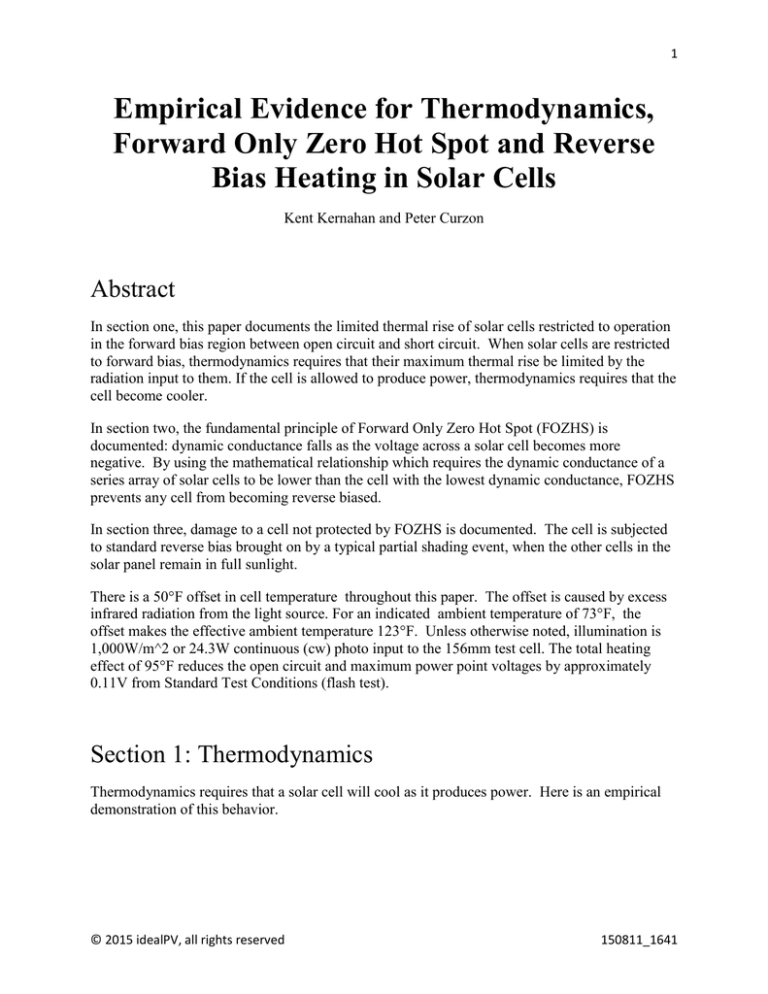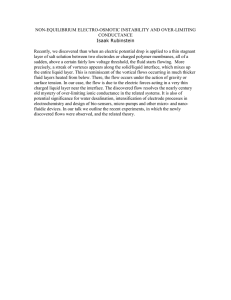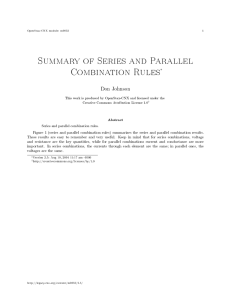
1
Empirical Evidence for Thermodynamics,
Forward Only Zero Hot Spot and Reverse
Bias Heating in Solar Cells
Kent Kernahan and Peter Curzon
Abstract
In section one, this paper documents the limited thermal rise of solar cells restricted to operation
in the forward bias region between open circuit and short circuit. When solar cells are restricted
to forward bias, thermodynamics requires that their maximum thermal rise be limited by the
radiation input to them. If the cell is allowed to produce power, thermodynamics requires that the
cell become cooler.
In section two, the fundamental principle of Forward Only Zero Hot Spot (FOZHS) is
documented: dynamic conductance falls as the voltage across a solar cell becomes more
negative. By using the mathematical relationship which requires the dynamic conductance of a
series array of solar cells to be lower than the cell with the lowest dynamic conductance, FOZHS
prevents any cell from becoming reverse biased.
In section three, damage to a cell not protected by FOZHS is documented. The cell is subjected
to standard reverse bias brought on by a typical partial shading event, when the other cells in the
solar panel remain in full sunlight.
There is a 50°F offset in cell temperature throughout this paper. The offset is caused by excess
infrared radiation from the light source. For an indicated ambient temperature of 73°F, the
offset makes the effective ambient temperature 123°F. Unless otherwise noted, illumination is
1,000W/m^2 or 24.3W continuous (cw) photo input to the 156mm test cell. The total heating
effect of 95°F reduces the open circuit and maximum power point voltages by approximately
0.11V from Standard Test Conditions (flash test).
Section 1: Thermodynamics
Thermodynamics requires that a solar cell will cool as it produces power. Here is an empirical
demonstration of this behavior.
© 2015 idealPV, all rights reserved
150811_1641
2
Fig.1
Fig. 2
Fig. 3
In each of the figures, a solar cell is operating at a specified current and voltage as reported by
the multimeters, and its temperature is recorded with thermal imaging. The hottest temperature
is marked by a red dot at the center of the white patch.
In Fig. 1, the cell is open circuit (0.000A, 0.472V), is producing no power, and its temp is 167°F.
In Fig. 2, the cell is short circuit (8.077A, 0.001V), is producing no power, and its temp is 167°F.
In Fig. 3, the cell is running at maximum power (7.422A, 0.331V, 2.456W), and its temp is
162°F. Because electrical power is being removed from the cell, it is running cooler than when
the same cell is in either the open or short circuit condition, just as principles of thermodynamics
require.
In a solar panel, the nominal internal temperature rise is about 1.8°F per watt. One full sun of
input power is about 24.3W to a 156mm cell. Provided a solar cell is operated between open
circuit and short circuit, the maximum temperature rise will be no more than about 44°F. The
temperature rise will be less when the cell is delivering power. Note that 123°F + 44°F =167°F.
Now that we have empirical evidence on thermodynamics, let's proceed to Forward Only Zero
Hot Spot (FOZHS).
Section 2: Forward Only Zero Hot Spot
FOZHS makes use of dynamic conductance to keep each solar cell forward biased in a series
array of cells. Dynamic conductance is the change in current divided by the change in voltage.
FOZHS is based on the principle that a solar cell's dynamic conductance falls as the voltage
across the cell becomes more negative. The mathematics of conductance requires that the
dynamic conductance of a series array of solar cells will always be lower than the lowest
dynamic conductance cell in the array. Therefore, maintaining high conductance for the array
prevents any individual cell from becoming reverse biased.
© 2015 idealPV, all rights reserved
150811_1641
3
In an idealPV, reverse bias is prevented by calculating dynamic conductance from the small
ripples in voltage and current that are caused by the internal idealPV's internal power
converter. This converter brings the ~130VDC @ 2A internal cell array operating point down to
a standard 35V @ 7.4A at the output of the panel. Should any cell begin to show signs of
approaching reverse bias, the condition is detected as a low dynamic conductance, and the
FOZHS controller reduces the load on the internal cell array to increase dynamic
conductance. Maintaining high conductance for the cell array prevents the weakest cell from
entering reverse bias.
Let us observe this in action by adjusting the cell voltage near the maximum power point.
First we set the cell near maximum power. Next we switch the meters to delta mode. The meters
store the voltage and current near maximum power as references. The meters are now reporting
current and voltage as differences (deltas) relative to the reference point near maximum power.
The large numbers report the difference from the reference voltage and current, as displayed by
the triangle (delta) to their left; the reference values of current and voltage are reported in small
numerals at the bottom of the displays. Note that although only two digits are displayed, the full
precision of the reference values are used.
Now we adjust the operating point of the cell down by about 0.050V (so that it becomes more
negative) and note the actual voltage and current delta.
Fig. 4
Fig. 5
Fig. 6
In Fig. 4, we decrease the voltage by 0.048V, and we note that the current increases by 0.399A.
This is a dynamic conductance of 0.399A / -0.048V = -8.313S (Siemens). In Fig 5, we start with
the cell near zero volts, and we read a dynamic conductance of 0.002A / -0.050V = -0.040S. We
see that as we move from a voltage near maximum power to a voltage near reverse bias, the
conductance becomes more than 200 times smaller (-8.3S/-0.04S=207.5).
Note that when an array of solar cells are connected in series in a solar panel, the dynamic
conductance of the array will be less than that of the cell with the lowest dynamic conductance.
Now that we have seen how FOZHS may be used to prevent reverse bias, let's consider what
happens without FOZHS.
© 2015 idealPV, all rights reserved
150811_1641
4
In the next section we will subject a cell to standard reverse bias conditions. This results from
about 20% shade of a single cell with the remainder of the solar panel in one sun.
Section 3: Hot Spot
Fig. 7
Fig. 8
Fig. 9
By maintaining optimal conductance, FOZHS prevents hot spots. The following is what happens
without FOZHS.
In this typical hot spot event, the partially shaded cell is subjected to around 80% of one sun.
The balance of the other un-shaded cells in a typical panel will produce about 100W of reverse
bias electrical power into the shaded cell. This is a standard reverse bias condition from a single,
typical hot spot event, and this situation arises in an array of solar panels any time a cell on one
of the panels becomes partially shaded.
In Fig. 9, this situation is reproduced: a reverse bias of -12.045V is placed across the cell,
allowing 8.009A of current to flow the wrong way (about 96W of power). This condition was
allowed to persist for three minutes; the temperature of the cell rose to greater than 370°F, as
seen at the red dot in Fig. 9. Note that the white pixels are transient thermal peaks that saturated
the thermal imager.
In the sequence above, the cell experienced interconnect damage on two of its three ribbons (Fig.
7, additional detail in Fig. 8). The center sections of the left and middle wire ribbons have
detached from the cell due to solder failure. Under the extreme heat of the hot spot, the cell
contracted, while the silver coated copper wire expanded. When the solder failed, the wire
relieved its strain by buckling outward from the cell. As the cell cooled, the solder returned to its
solid form while the temperatures were still quite high, locking the copper into the deformed
position. In figure 8, the solder formed a column near mid span of the displaced ribbon. The
solder’s grey color indicates work stress fatigue damage. Decomposition of the solder into large
grains can also be seen at the cell end of the column.
© 2015 idealPV, all rights reserved
150811_1641
5
In this case, the cell was not contained in a solar panel, so the solder failure event is easy to
see. When this happens within a solar panel, visual inspection is difficult prior to catastrophic
interconnect failure. The encapsulating materials prevent the wire ribbon from lifting visibly, but
the damage to the solder and connection caused by extreme heat may occur nonetheless. As the
current carrying capacity of the damaged interconnects degrades, the surviving interconnect is
forced to carry current in excess of its ampacity capability. There are documented cases where
this resistive heating actually burns through the back skin of the solar module. Ultimately, the
current overload can cause the last remaining interconnect to fail; it will carry a DC current large
enough to destroy the panel, and potentially cause a plasma arc. Plasma arcs sustain
temperatures in excess of 14,000°F, and can propagate across panels and system cables. They
will result in the catastrophic destruction of the panel and beyond.
Section 4: Summary
Thermal physics requires that solar cells restricted to operation in their forward bias region
between open circuit and short circuit show only a limited rise in temperature over ambient. The
rise in temperature is limited by the radiation absorbed, and if the cells are allowed to produce
power, they cool. Experiments confirm this.
Further, the principle of FOZHS is confirmed: dynamic conductance falls as the voltage across a
cell becomes more negative. Because the conductance of a series array is always lower than the
lowest conductance cell, FOZHS prevents any cell from becoming reversed biased.
Finally, damage to a cell not protected by FOZHS is documented. Standard (and mild) field
conditions are replicated, and the cell suffers permanent damage.
© 2015 idealPV, all rights reserved
150811_1641





